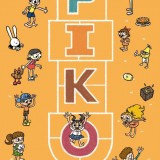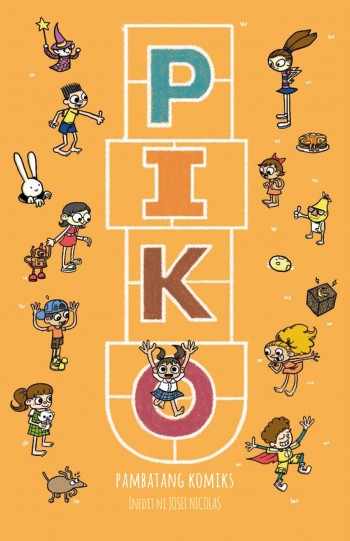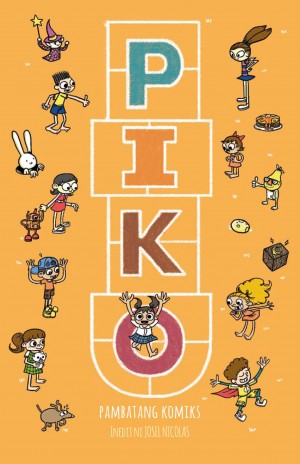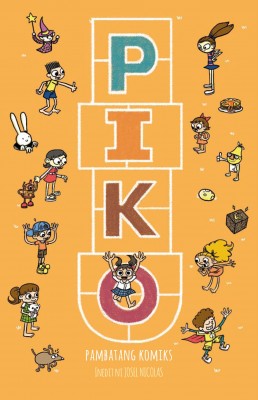
GRAPHIC NOVEL REVIEW: PIKO: Pambatang Komiks
Innocence, Values & Childhood Philippine independent comic era is still going strong. And another anthology showcasing some of the great potentials will be unleashed on Free Comic Book Day. The name is PIKO: Pambatang Komiks (Josel Nicolas as editor). The name itself is very tantalizing for the twenty stories alone make our consciousness pique our […]
Philippine independent comic era is still going strong. And another anthology showcasing some of the great potentials will be unleashed on Free Comic Book Day. The name is PIKO: Pambatang Komiks (Josel Nicolas as editor). The name itself is very tantalizing for the twenty stories alone make our consciousness pique our aesthetic interest, and how innovative some of the upstarts can hold their horses with their veteran counterparts. After viewing and digesting all of the visual treats, most of the rookies have great potentials and even so, promises. Clocking almost a hundred pages, both the writers and/or the artists present their different perspectives in the most accessible and charming way possible for the title itself is synonymous with innocence, simple, childish fun, and most significantly, exuberating. I am basically impressed with the overall quality of this anthology for many of the visual narratives remind me the nostalgic days of reading Funny Komiks in the streets, sidewalks, or inside a decent children’s library! Very playful and bouncy, funny at times, downright wacky, these stories are worth your time to share or tell these with your adorable nieces, nephews, godchildren, children (or grandchildren), and even schoolchildren if you are in the teaching profession. So, let’s scrutinize the twenty children comic stories, shall we?
Adam David and Laraine Gazmen present the opening salvo (Awit ng Pagagala) and the dénouement (Awit ng Pagbalik) of the anthology in the elegant and optimistic way to make everything in midst of a smooth transition. David’s lyrical and poignant poems synchronize well with Gazmen’s vibrant and soulful watercolor painting that illuminates the innocence, charm, and playfulness of being children.
Josel Nicolas has five selections to either enjoy or perhaps, bewildered upon. In Captain Old vs. Pambatang Komiks, he simply shows the joys and (and some perils) of reading both serious (read: “old” and “Western”) comics to children’s via the “follow the arrow” sequence. The art in general are simple but quirky, hilarious and colorful as expected. The downsides are the rather confusing sequential pattern that is similar to the complicated organizational flowchart (plus the lettering is a bit a challenge to read). This is the same obstacle I find with Benjo Bato and Hotcakes x Jimbob and Ang Ulan. In his two part Salamin-Salamin and Salamin-Salamin 2, the first one is a child’s game of reflection, especially getting the message through mirror-reading. Naturally, reading the message is a strain to some eyes since the lettering again is small, and mirror-reading game is a more challenging game for young toddlers alike. However, the second one nails the point of having a good father-and-son relationship. If the old adage of “what you reap, you sow”, this one shines.
Trizha Ko’s Dressing Up with Dolly is well-organized, even if it colored in two to three color schemes. A tale of daydreaming and the longing of a long weekend and fun, but it implies of skipping school altogether (personally, I had that thoughts then). Anthropomorphic in illustrating characters to help the simple narrative more effective and bouncy, this one reminds old readers the nostalgic times of the younger years during the weekends. What bugs down this is the small lettering that could have maximized to greater effects to retain the sense of guiltless pleasures of Dolly.
[CHECK OUT… KOMIKS PREVIEW: Piko: Pambatang Komiks]
The Sculptor by Rommel Estanislao is an interesting silent skit that is also drawn to some of the minutest details ever in the children illustrative book yet. However, the sequence is simply too confusing at the last parts of this silent narrative. I personally fail to grasp what comes first, the unwrapping or the surprise moment. I’m still scratching my head.
Marlon Hacla and Apol Sta. Maria collaborated here with their contribution entitled Limang Kuwento. Literally five (short) stories, they basically look like a fill-in-the-blank presentation that plays a riddle game moment. Seriously, I still fail to figure out the precise or correct answers to the blanks on the thought balloons. Furthermore, Sta. Maria’s childish, simplistic and stalled art helps a bit to the mystery behind the riddled worlds. His shading on some anatomical parts doesn’t help either for that creates some unnecessary meanings as well. Personally, this selection is the weakest link in this anthology.
Julius Villanueva’s Lucky reminds me of an all-time animated film classic – The Land Before Time. If that’s the inspiration of this very detailed, clean and a highly articulate tale of primal fear and family, then this one is surely an excellent piece of art. Beautifully made and the narrative almost brings me to the mind of the baby horned protoceratops that is “lucky” enough to reunite with his family and making a friend along the way. I simply could not find the proper words to describe this heartwarming tale of familial connectivity.
Adam David has a collaborative effort with Mervin Malonzo which produced Inigo’s Day Out. David is definitely aware of the continuing phenomenon of the zombie apocalypse in our pop culture consciousness, but instead of terrifying the innocence of young readers, why not made them a bit adorable instead! And even so, instead of an entire horde of flesh rotting appearance, how about mechanizing them! Malonzo re-imagined his vision of a troupe of zombie-robots dreaming scenarios that may probably a product of a rather weird childhood nightmare. However, this is the only selection that has a cliffhanger of sorts. Will the zombie-robots materialize or emerge from the deepest abyss of the sub consciousness… ABANGAN!
Rob Cham (with Karize Uy) explored the concept of wish and being contented in Kukote Ko (?). A three-color palette and focuses on two friends. One of which has a faceless type who wishes he has a face like no others. However, the proceeding narrative is a bit terrifying even to the young readers’ taste (it has a borderline shock value and creepiness to say the least here). But in the end, if the children can read through this, they may appreciate the things they have at hand. This is a highly detailed and well-thought skit though this is definitely not for the weak heart.
The Magic Brush by Daniela Go is a breeze air for it set on the pre-Hispanic or pre-Spanish era, you know, the babaylan-datu-alipin times. A young princess (or lakambini/guinoo/panginoon rank, but nothing stated which is which) was literally being cocky to her babaylan (or priestess/shaman) of not finding the very thing the former wanted with. The story is actually a morale tale of truly Filipino—respect to the elders that is relevant to our today’s generation of readers (do I need to spell this out here?). The only awkward here is the predominant usage of English as a dialogue instead of using more baybayin or ancient Philippine terms or words.
Speaking of relevance, how to engage a fight with cowardly bullies? This is theme Joanne Ceasario and Michelle Bacabac explored in Treat. We experience being the bullies and the bullied. This selection hits the core for unlike the other darker (and mature) stories that lead to predictable results, Treat routed to a more positive option to show children that vengeance results to nothing, and even so to more dire consequences. To make this story more meaningful, the art design is more geared to the Adventure Time illustrations that are the hype to young children (especially girls) these days. Since the said television show has dealt with the kind of awareness. Treat may be a called as a reminder of anti-bullying stance.
JP Palabon emphasized the power of perseverance through education in Imposible. Clear line, crisp detailed illustrations and effective red-and-white contrast combination made this simple yet meaningful tale of ambition through studying all the way to the top in the guise of an imp. At first glance, it could be a Faustian inspired tale, but that’s only in the beginning, nothing more. The rest is pure artistry and with a positive note on having a strong education as a mean of succeeding to a better future and oneself. Thus, the title serves as a challenge for children to pursue their dreams by having a good and hard earned education.
Ellezier Ominoreg and Carlorozy Clemente attempted to reach and teach young readers the sense of responsibility in the fantasy inspired tale named Bilog Bilog Ba Ito?. The girl was convinced by his father to take care with the “Bilog Bilog” until it hatched. Though a giveaway, we see Clemente’s watercolor illustrations of the possible species inside the said subject. And, through this tale, we glimpse of teaching the readers of knowing how to be responsible or committed to their dreams or duties. Clearly disciplined on every panel to ensure a clear reading flow, this story proved that simple execution paves way to clearer and meaningful results.
On the other hand, Wina Puangco and Danielle Rina’s What Do You Want To Be When You Grow Up? tackled on the often asked question to our children. Instead of giving a clear cut answer, other casts tell the rather confused, if not understood, toddler, the strengths of their chosen or dream positions. The final answer was a product of, well, synthesizing the overall aspirations into a singular moment. Personally, the story carried the skit for I have reservations on the art itself. The creepiness of portraying children, particularly the lead character, was again a borderline of the terrifying and total weirdness, if not a bit childish way of interpreting things. Similar to Limang Kuwento, this selection is at the bottom rank in my view.
Manix Abrera contributed in this anthology by fusing his avant-garde style with Karize Uy’s script and Kyth Pallogan’s minimalist background touches in Si Ella at Ang Sigwa. This is the story of resilience in the midst of calamity, particularly during powerful typhoons. I know many of us are still aware on the experiences we endured with typhoons Ondoy and Yolanda these past few years ago. But, we can relate easily with this simple but strong resonance of never bowing our heads so easily and have faith and sticking together with our family through thick and thin. Abrera’s signature characters synchronized well with Pallogan’s background, a virtual perfect fusion.
Bong Redila’s 19th century inspired illustrative style was a feast to behold upon for his approach reminded me of the drawing style our national hero Jose Rizal possessed. In penultimate skit Ang Kahon, he traced the box where the girl tried to retrieve it and return it to its rightful owner. It focused on the comedic effects from the start up to the end, and the value of returning things to owners clearly shown that it illustrated the fact that good presentation and wacky sensibilities can produce a satisfying nod to the good old times. The coloring is virtually yellow, but the Claire ligne approach made the illustrations so effective that it blended well with the said primary color.
[CHECK OUT… LET’S TALK KOMIKS: Josel Nicolas’ PIKO for Kids]
In the special feature, it caricatured the book’s contributors and their respective traits and/or characteristics. No colors was applied here, just an improvised sticks inspired drawing (naturally, the faces are grossly highlighted for hilarity sake). This was a good sendoff before the fading moments that comprised only with words before the Awit ng Pagbalik.
Specifically, each selection has its value theme trajectory for the young readers, ranging from responsibility, respect of elders, resilience, honesty, humility, family, morality, and good values. Every story has its wider spectrum of young demographics, but majority of the selections are actually all-age readers friendly types. Some illustrations here are a bit awkward to young readers’ sensibilities. I know for the fact that children love bright colors and upbeat and clear drawings. Perhaps, these are some young children have already developed a sense of liking various artistic approaches, hence some skits that geared to that same demographic targets. The lettering can be problematic to some young readers due to its rather small size in some stories. But nevertheless, this anthology is a great addition to the ever increasing number of good quality Pinoy indie works that need to be read by everyone else.


















